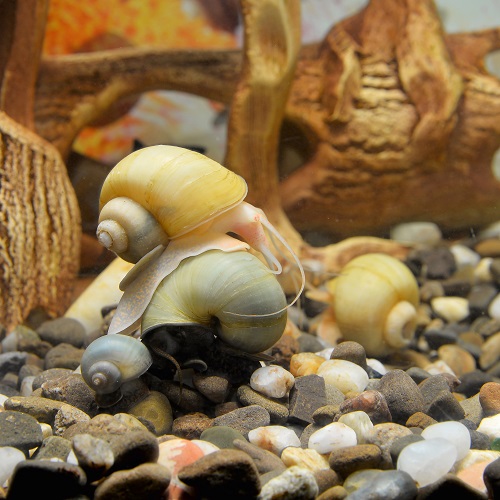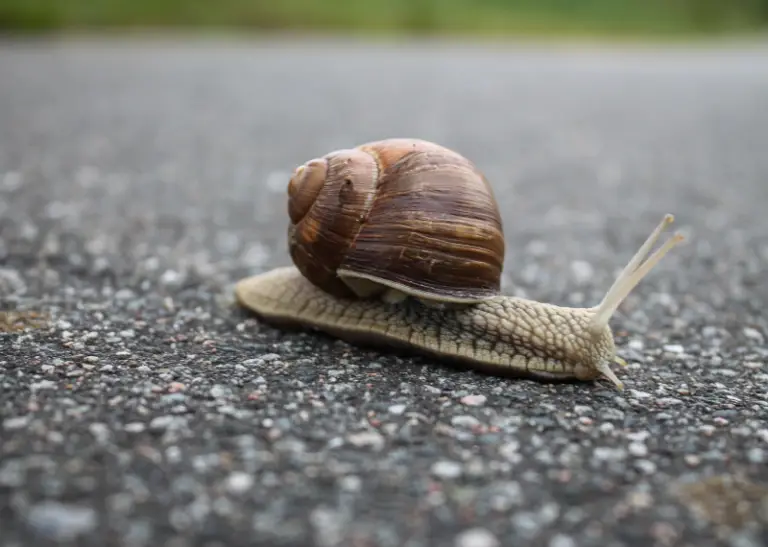How Big Do Assassin Snails Get? [Full Guide To Healthy Assassin Snails]

If you are having trouble with pest snails overrunning your aquarium, assassin snails may be your answer. How Big Do Assassin Snails Get? Not only are they colorful and fun to look at, but they will take care of that annoying infestation in a heartbeat. No pest snail problem? Assassins are still fun creatures to house. However, they are more difficult to care for than other snails, both in maintaining their water quality and making sure they get enough food.

If you are considering keeping one or several of these snails in your aquarium, keep reading to learn some great assassin snail care info including how big assassin snails get!
Contents
Table of Contents
What Is An Assassin Snail?
Assassin snails go by the scientific name Clea helena and are one of the most popular freshwater aquatic snails available in the aquarium trade. They are appealing to look at with their long, spiral shaped shells and their black and gold striped colorations. Yet, their looks aren’t what makes them so popular.
Pest Snail Eaters
The reason people love to keep assassin snails in their tanks is because they help aquarium keepers rid their tanks of pest snails.
Pest snails, like trumpet or bladder snails, enter aquariums easily. Most commonly, they will hitchhike into your aquarium by riding along on the surface of your new live plants. If you don’t bathe your plants properly before adding them to your tank, the pest snails will quickly take over.
Pest snails are asexual, so they reproduce on their own. Because of this, they will overrun a tank in no time.
Getting Rid of Pest Snails
It can be difficult to rid yourself of these snails. It’s tedious to pick them out by hand, and inevitably, you will miss some that are hiding under decorations or in the substrate.
Chemicals that kill snails are no good either because they are harmful to your fish and plant life. They will kill all the invertebrates in your tank, including pet snails, crabs, and shrimp.
Some species of loaches are good for ridding an aquarium of pest snails, but may not be suitable for some tanks. Some grow very large, while others are aggressive and won’t go well with a tropical aquarium.
So, what are aquarists to do? This is where assassin snails come in.
How They Eat
Assassin snails are carnivores, and while they like to eat a variety of meaty things, their favorite meal is snail.
The way that assassin snails eat is quite fascinating, although it can be traumatizing for the animal that has become it’s meal. In short, they reach into the aperture of the other snail’s shell and rip them out. Then they use their radula to scrape pieces of flesh off. You can read more about that process here.
Anyone who is having trouble with pest snails in their tank should consider adding an assassin snail to the mix. They will quickly decimate a population of pest snails and get your aquarium back to its former glory.
How Big Do Assassin Snails Get?
You may be wondering, how big do assassin snails get? Assassin snails are one of the smaller species of snails, and they will usually be about 3/4 inches in length when they’re purchased from the store. Although it is not common, if assassin snails are cared for exceptionally well, they can reach up to 3 inches in length.
In order to allow your assassin snail to grow to its full potential, not only will you need to care for it properly, but you will also need to keep it in an aquarium of the right size. We’ll go over that more in a bit.
How Fast Do Assassin Snails Grow?
Considering assassin snails only live to about 2 years of age, their rate of growth is fairly slow. They grow up until 6 months of age when they are considered sexually mature.
Their rate and size of growth will also vary depending on how well they are fed and how well the tank is being maintained. A well-fed snail in an aquarium with ideal water conditions will grow larger quicker than one struggling to find food in a dirty tank.
Check out this video:
What Is The Best Assassin Snail Tank Size?
If you would like them to grow to their full potential, you will want to house them in a tank of at least 30 gallons.
Why Larger Tanks Are Better
Besides larger tanks allowing them to grow to their full size, they are more adept at maintaining stable water conditions. Contrary to popular belief, larger tanks are more beginner friendly than small tanks.
Water parameters in small tanks need to be checked more often than larger tanks because they are always changing.
Because assassin snails are more sensitive to changes in water conditions, it’s better for them to live in a larger tank where these drastic changes are less likely.
Bioload
Another reason it is good to keep assassin snails in a larger tank is due to bioload. An assassin snail’s main diet consists of other snails and invertebrates. If you don’t have enough pest snails for your assassin to feed on, you will have to supply them with some.
The more snails you keep in your tank, the more of a bioload is created. You can’t keep many organisms in one tank or it will increase the presence of ammonia and nitrite, creating an unhealthy and dangerous situation for your pets.
Many people find that keeping assassin snails in small groups is more effective at ridding their aquarium of pest snails. This creates a larger bioload.
Therefore, it is best for everyone involved that assassin snails are housed in larger tanks.
What Tank Conditions Help Assassin Snails Thrive?
Assassin snails are tropical snails, so their ideal living conditions are similar to that of other tropical species. However, just like any species of animal, assassin snails have their own preferences and conditions where they thrive.
These snails aren’t as hardy as some of the other aquarium snails, so you need to take extra care of monitoring your water parameters. They don’t handle shifts in the water parameters well, so make sure your tank is well filtered. Also make sure that you are doing weekly cleanings and water changes.
Since they are more sensitive than other species, take care when choosing chemicals that go into your tank. This includes medications and plant fertilizers. Avoid anything with copper which is fatal to all species of snails, not just assassin snails.
Because they are tropical, they will do best in tanks with a heater, and should be kept at temperatures between 75-80oF. If you keep the temperature too low, they may become sluggish and go into a state of torpor, becoming dormant in their shells for long periods of times.
Low temperatures also compromise their immune systems and make them more susceptible to disease and sickness.
Although these snails are more sensitive than other species, they do tolerate a larger range of pH. They can live in a pH anywhere from 7.0-8.0, making them easier to keep with a larger range of fish species.
| pH | Ammonia | Nitrites | Nitrates | Temperature | Hardness |
| 7.0-8.0 | 0ppm | 0ppm | <40ppm | 75-80oF | Hard |
What Do Assassin Snails Eat?
Assassin snails don’t like algae and detritus like other snails, so many new owners wonder what to feed assassin snails.
Assassin snails are carnivores and love to eat meaty foods. Their favorite thing to eat is other snails, but they are not averse to eating other soft invertebrates.
It’s not a good idea to keep small crabs or shrimp with assassin snails because they will quickly become a tasty snack.
Usually, larger snails like apple snails and nerite snails will be safe to house with assassin snails. Assassins usually won’t go after larger snails as long as they are well fed, but that is largely determined by you.
If you don’t keep your assassins well-fed, they will go after your larger snails, and they will often succeed. They are great ambush predators and are adept at peeling snails from their shells.
Not only that, but assassins are great group hunters. They often join forces to gang up on larger prey animals to take down together.
So, what can I feed my assassin snails?
Besides snails, shrimp, and crabs, assassins will eat anything meaty or protein based. This includes worms, dead fish, and protein-rich fish food.
Do Assassin Snails Eat Algae?
Assassin snails are carnivores and will not eat algae or plants. This can be frustrating for hobbyists with an overgrowth of algae, but there are plenty of other snails to tackle that problem, like nerites and apple snails.
How Long Do Assassin Snails Live?
Generally, it is common for assassin snails to live to about 2 years of age. It is possible for them to live longer if they have been well fed and their water conditions have been well maintained.
Although it is not common, some aquarists have reported their snails living up to 5 years.
Conclusion
All in all, assassin snails are one of the more difficult aquarium snails to care for, but they are well worth it. If you take care of them properly, you will have beautiful, helpful snails to last you for years.
If you aren’t up for the challenge though, check out some aquarium snails that are easier to care for like the apple, mystery, or nerite snails. There’s an option for everyone.



![Can You Eat Apple Snails? [Read This First!]](https://allourcreatures.com/wp-content/uploads/2021/11/eating-snails-768x514.jpg)


